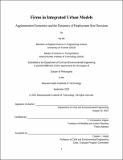Firms in Integrated Urban Models: Agglomeration Economies and the Dynamics of Employment Size Decisions
Author(s)
He, He
DownloadThesis PDF (5.631Mb)
Advisor
Zegras, P. Christopher
Terms of use
Metadata
Show full item recordAbstract
Jobs are key determinants of urban phenomena ranging from daily trip patterns to urban structure. Despite their importance, the representation of jobs and firms in integrated urban models is limited. Existing approaches are exceedingly static, often lack theoretical underpinnings, and rarely account for the impact of agglomeration economies.
I propose an agent-based dynamic programming structural model of firms’ job creation and lay-off decisions. It models the evolutionary trajectory of firm sizes rather than discrete jumps between presumed steady states. Firms are forward-looking rational agents, attempting to follow the employment size adjustment trajectory that maximizes their present value of all future profits in face of a stochastic adjustment process. I model firms’ decision-making as a continuous-time Markov decision process, solved via dynamic programming. To estimate the model’s parameters, which are firm-specific, I formulate a hierarchical Bayesian estimation procedure. I repeatedly sample from the posterior distributions of the hyperparameters using a nested Gibbs and Metropolis-Hastings sampling algorithm.
With a panel micro-dataset of businesses in the Greater Boston Area, I apply the model to explore the heterogeneous impacts of agglomeration economies for manufacturing, professional services, and food and accommodation services firms. The empirical findings broadly align with urban economic theory. However, uniquely, the dynamic structural model enables me to distinguish between benefits that increase productivity and those that reduce labour market friction. Overall, I find that employment size adjustments are more costly for more skills-intensive sectors. Finally, using the estimation results from Boston, I examine the estimated impacts of a major urban rail line investment – the Green Line extension – in terms of job creation and gross production increase, and the cost of labour market frictions in terms of firms’ foregone profits.
Date issued
2022-09Department
Massachusetts Institute of Technology. Department of Civil and Environmental EngineeringPublisher
Massachusetts Institute of Technology